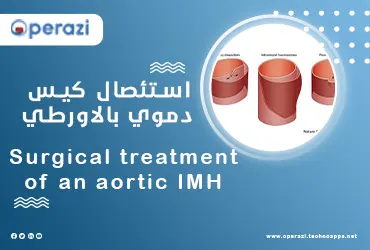Surgical treatment of an aortic IMH
The aorta is a large artery that carries oxygen-rich blood from the left heart chamber to the rest of the body. A rupture in the small blood vessels that supply the walls of the aorta leads to an intra-aortic hematoma. Surgical treatment of an aortic IMH is performed as a result of aortic dissection because there is bleeding in the aortic wall, usually from the vessels without internal rupture, and it forms part of the acute aortic syndrome along with Combined with penetrating atherosclerotic ulcers and classic aortic dissection. Usually, intra-aortic hematomas appear in elderly hypertensive patients, and the same condition may also develop as a result of acute chest injury, aortic wall injury or penetrating atherosclerotic ulcer. operazi can perform the Surgical treatment of an aortic IMH in installments. For our services, click here.
What is Surgical treatment of an aortic IMH?
Surgical treatment of an aortic IMH is performed when an intra-aortic hematoma occurs due to damage to the tiny blood vessels along the aortic wall. Blood leaks from the blood vessels and accumulates within the walls. It is also considered a form of aortic dissection (caused by a tear in the inner layer of the aorta).
What causes aortic IMH?
The main factor that leads to an aortic IMH is unknown. However, there are certain factors such as:
• Leaking blood from the middle layer of the aorta leads to the formation of blood-filled spaces, which weakens the wall of the aorta without tearing the outer layers of the aorta.
• High blood pressure causes arterial walls to thicken, affecting normal blood flow.
• Atherosclerosis causes the buildup of fats (plaques) and other substances in the arterial walls. As a result, it causes narrowing of the arteries.
• A penetrating aortic ulcer (PAU) is an uncommon condition that predisposes to an intra-aortic hematoma. It mainly affects the lower part of the aorta (descending aorta). The plaque that forms in the aorta ulcerates, initially confined to the outer layer. Later it penetrates the middle muscle layer and causes a hematoma. Therefore, it is referred to as a secondary intra-aortic hematoma, and operazi is the best site and the first to provide a medical consultation service.
See also: surgical prostatectomy
What are the symptoms of aortic IMH?
Symptoms vary from patient to patient. The most noteworthy are:
• Chest pain can be severe and may spread to the back.
•Stomach ache.
• Loss of consciousness (fainting).
• Pulse rate.
• Hoarseness (hoarse voice).
•Shortness of breath.
• Weakness.
• Anxiety and excessive sweating.
What are the complications of aortic IMH?
Complications due to intra-aortic hematoma are as follows:
• aortic IMH is characterized by rupture of the inner layers of the aortic wall, which leads to blood flow between the layers.
Cardiac tamponade is characterized by the accumulation of blood or fluid within the sac that covers the heart, usually caused by a rupture of the upper part of the aorta. Symptoms include loss of consciousness, low blood pressure, and altered mental status.
• Pericardial effusion occurs due to the accumulation of blood from the ruptured part of the aorta within the heart, and with operazi the first site to provide medical reports after the operation.
How is aortic IMH diagnosed?
Early and accurate diagnosis of an intradural aortic hematoma is essential because it can lead to complications. Diagnostic method includes:
• Magnetic resonance imaging (MRI): This is a confirmatory test that shows accurate images of the aortic wall. It helps differentiate between intra-aortic hematoma and atherosclerosis.
• Computed tomography (CT): In patients with intra-aortic hematomas, imaging shows crescent-shaped areas along the aorta without rupturing layers in the aortic wall.
• Transesophageal echocardiography (TEE) involves inserting a specific probe (catheter) through the food tube to assess the heart valve structure, detect any clots, etc. It appears that the thickness of the aortic wall is greater than 7 mm, which is also a feature of atherosclerosis. Therefore, the results of the echocardiographic method are not considered valid in the diagnosis of intra-aortic hematoma.
What is the differential diagnosis of aortic IMH?
• Aortic inflammation is an inflammatory condition affecting the aorta that leads to a thickening of its wall, similar to an intra-aortic hematoma.
• Atheroma is characterized by the accumulation of fat deposits around the arteries of the heart, which leads to a narrowing and restriction of blood flow. The distinguishing feature is that the fatty deposits occur in a localized area, while the internal aortic hematoma affects the larger area of the aorta.
• Aortic dissection has similar clinical features to aortic hematomas, and radiographic techniques are essential in differentiation.
See also: drainage of renal abcess
How to treat aortic IMH?
Immediate management is planned when imaging findings are abnormal, with increased complications such as aortic rupture, pain, and unstable blood pressure. Asymptomatic patients may be observed and followed up with regular imaging.
1- Medications: There are no specific medications to treat an aortic cyst. Some medicines like -
• Beta-blockers (propanol, metoprolol) or calcium channel blockers (diltiazem) are given intravenously to patients with high blood pressure.
• Suggests analgesics to relieve the patient's pain.
2- Surgical management is planned mainly in patients with type A intra-aortic hematoma where there are fewer complications in patients with type B. They include:
Thoracic aortic endoscopic repair (TEVAR) is a minimally invasive procedure that involves placing a metal tube (stent) covered with implanted tissue (grafts) along the defective area of the aorta. This stent allows proper blood flow and limits blood accumulation in a localized area of the aorta.
• Open surgical repair is a traditional method of repairing the aorta by implanting a graft. Unlike repairing the aorta from the inside, a larger incision is made in this procedure.
3- Resection of a bloody cyst in the aorta
• The surgery will focus on removing the damaged portion of the aorta and placing a graft in place of the removed portion to prevent blood from reaching the aortic wall.
• The graft is generally a tube made of a synthetic material that helps restore function to the damaged area. In some cases, a blood cyst may have damaged the aortic valve. If this happens, the valve is often replaced during the same surgery, as you can at operazi website offer the patient the best treatment option in installments.
.







00 التعليقات